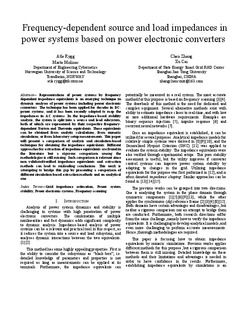Frequency-dependent source and load impedances in power systems based on power electronic converters
Chapter
Accepted version
Permanent lenke
http://hdl.handle.net/11250/2445273Utgivelsesdato
2016Metadata
Vis full innførselSamlinger
Originalversjon
Frequency-dependent source and load impedances in power systems based on power electronic converters. I: 19th Power Systems Computation Conference PSCC 2016. IEEE conference proceedings 2016 10.1109/PSCC.2016.7540891Sammendrag
Representations of power systems by frequency dependent impedance equivalents is an emerging technique in dynamic analyses of power systems including power electronic converters. The technique has been applied for decades in DC-power systems, and it has been recently adopted to map the impedances in AC systems. In the impedance-based stability analysis, the system is split into a source and load subsystem, both of which are represented by their respective frequency-dependent Norton and Thevenin equivalents. These equivalents can be obtained from analytic calculations, from numeric simulations, or from laboratory setup measurements. This paper will present a comparison of analysis and simulation-based techniques for obtaining the impedance equivalents. Different approaches for extraction of impedance equivalents are found in the literature but a rigorous comparison among the methodologies is still missing. Such comparison is relevant since non validated/verified impedance equivalents and extraction methods can lead to misleading conclusions. This work is attempting to bridge this gap by presenting a comparison of different simulation-based extraction methods and an analytical one.
